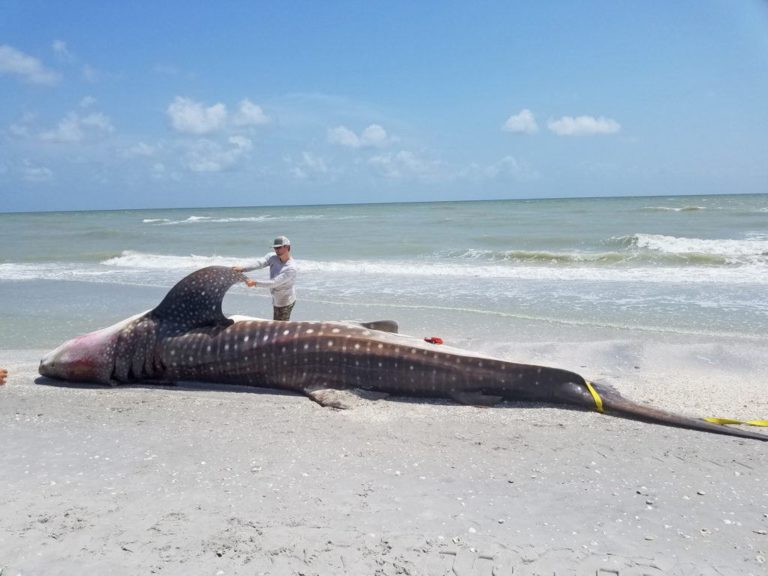Tell Congress: Take Action on Deadly Algal Blooms
By: Ellen Simon

Red tide off Florida has turned beaches into morgues, as scores of dead fish and rotting corpses of marine mammals litter shores. Please call your Representatives and Senators and ask them to stand up for healthy waterways by renewing the Harmful Algal Bloom and Hypoxia Research and Control Act.
[CongressLookup]
A devastating red tide prompted Florida’s governor to declare a state of emergency last month along 130 miles of Florida coast.
While Florida has experienced red tide before, this year’s 10-month bout is causing a massive die-off of marine life, and devastating local economies. Red tide “has never killed marine mammals on this scale before,” Suncoast Waterkeeper Andy Mele wrote in an opinion column. Inhaling red tide particles blown by the wind can also irritate people’s lungs and eyes, leading to an increase in pneumonia cases and hospital admissions for respiratory problems.
Red tide is caused by the rapid growth of a microscopic algae called Karenia brevis, which can grow to algal blooms so large they can be seen from space. Karenia brevis produces potent neurotoxins, which can affect animals’ central nervous systems, killing them.
This year’s red tide has brought to the fore how damage to one waterway can affect another. The same nutrient pollution from massive releases of polluted water from Lake Okeechobee, which is causing massive blue-green “slime” algal blooms in rivers such as the Caloosahatchee, also flows into the ocean and feeds the red tide.
“The Harmful Algal Bloom and Hypoxia Research and Control Act, if passed, would enable, better monitoring, prediction, and public health notification for communities affected by algal blooms,” said Calusa Waterkeeper John Cassani, who works to protect the Caloosahatchee River. “This is an emergency. We need Congress to act.”
The severity of this year’s red tide is just one example of a national problem: Harmful algal blooms, in which an overgrowth of phytoplankton overwhelms an area of fresh or marine water.
The blooms have increased in size and severity in recent decades, fed by increases in nutrients, such as phosphorus and nitrogen, in our waterways. Those increased nutrient levels are caused by misuse of fertilizer and improper disposal of animal waste from industrial agriculture, as well as by fertilizer runoff from lawns, and discharges from sewage and industrial facilities.
Despite the health, environmental and economic damage done by this year’s red tide and other harmful algal blooms around the country, which caused beach closures and health advisories in 18 states in August alone, Congress has failed to pass a bill that would renew funding for a program that brings government agencies together to detect, monitor, assess, and predict events like this.
With daily news of sea turtle deaths, human illness, and lost tourism, it is past time to take action.
This week, please call your Representative and Senators and urge them to reauthorize the Harmful Algal Bloom and Hypoxia Research and Control Act. Here are some talking points to get you started:
- My name is [YOUR NAME] and I am a resident of [ZIP CODE] in [STATE].
- I am calling because I would like Congress to reauthorize the Harmful Algal Bloom and Hypoxia Research and Control Act.
- I am concerned about harmful algal blooms. I know that they are a nationwide problem with real impacts on people’s health and local economies.
- Harmful algal blooms are caused by a failure to regulate the release of nutrients to our waterways.
- I would like Congress to take action to address this growing threat.
- A good first step would be for the House of Representatives to pass the bipartisan “Harmful Algal Bloom and Hypoxia Research and Control Amendments Act of 2017,” House bill number 4417.
- The Senate already passed this bill, and now the House needs to move it forward.
- Thank you for standing up for healthy waterways and communities.
Note: If you know any specific information about harmful algal blooms and their causes in your area, or if you live in Florida and can describe what red tide has done to your community, please include that in your conversation!
Want to do more? Your state can also take action to stop algal blooms. Take a look at what your state is doing and reach out to your state legislators and governor to ask them to take action. For instance, Ohio’s Governor took executive action this summer to stop algal blooms in Lake Erie.
**Photo by Florida Fish and Wildlife Conservation Commission